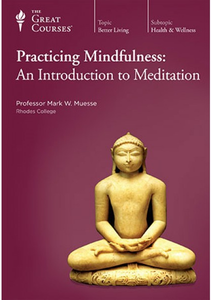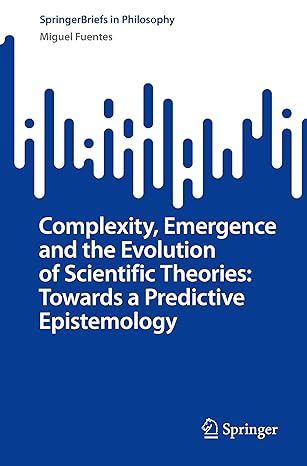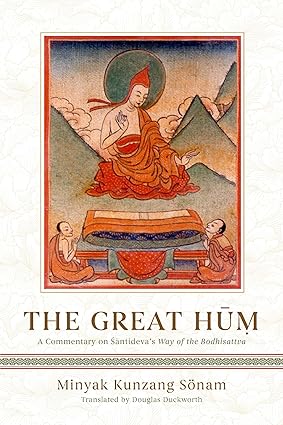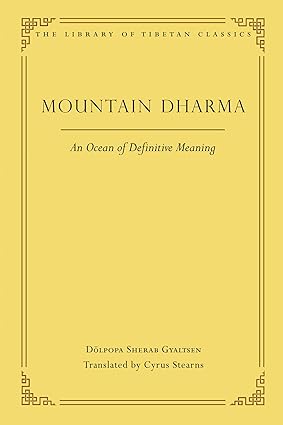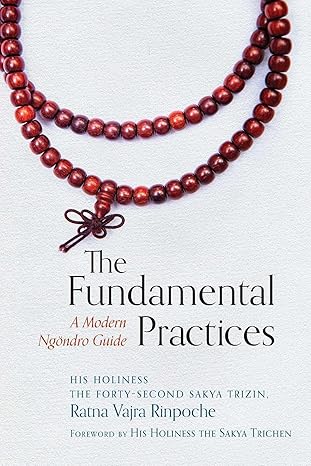TTC Video - Practicing Mindfulness: An Introduction to Meditation
24xWEBRip | English | M4V | 640 x 480 | AVC ~1500 kbps | 29.970 fps
AAC | 128 kbps | 44.1 KHz | 2 channels | 12:29:57 | 8.55 GB
Genre: eLearning / Education lectures: Psychology, Meditation
What is meditation? For thousands of years, human beings have practiced refined techniques of mental focusing, designed to change the habitual conditioning of the mind. Central to many spiritual and philosophical traditions and known in English as "meditation," these practices are considered a major means for enhanced awareness and self-mastery.
In recent decades, modern science has dramatically confirmed what advanced meditators have long claimed—that meditation, correctly practiced, offers deep and lasting benefits for mental functioning and emotional health, as well as for physical health and well-being.
The many practical benefits of meditation include
marked and lasting reduction of stress;
increased ability to focus and concentrate, as well as clarity of thinking;
freedom from detrimental patterns of thought and emotion;
increased learning capacity and memory; and
greatly enhanced well-being and peacefulness.
If practiced consistently, the results are real and very far-reaching. In the largest sense, meditation allows you to live in harmony with the realities of the world—to embrace life's ever-changing impermanence, to live in equanimity with the inevitable ups and downs of being human, and to feel deeply connected to the whole of life.
Now, in Practicing Mindfulness: An Introduction to Meditation, award-winning Professor Mark W. Muesse of Rhodes College takes you on a dynamic exploration of your own mind, giving you a clear and useable understanding of the essence of meditation and how to practice it.
In 24 detailed lectures, using numerous guided exercises, Professor Muesse teaches you the principles and techniques of sitting meditation, the related practice of walking meditation, and the highly beneficial use of meditative awareness in many important activities, including eating and driving. As a major strength of the course, you learn in depth how to use the skills of meditation in working with thoughts and emotional states, in deepening sensory awareness of the body, and in becoming deeply attentive to the operation of your mind. Emphasizing clarity and practical understanding, this course will leave you with a solid basis for your own meditation practice and for bringing meditation's remarkable and empowering benefits to every area of your life.
چکیده فارسی
ویدئو TTC - تمرین ذهن آگاهی: مقدمه ای بر مدیتیشن
24xWEBRip | انگلیسی | M4V | 640 x 480 | AVC ~1500 kbps | 29.970 فریم در ثانیه
AAC | 128 کیلوبیت بر ثانیه | 44.1 کیلوهرتز | 2 کانال | 12:29:57 | 8.55 گیگابایت
ژانر: آموزش الکترونیک / سخنرانی های آموزشی: روانشناسی، مدیتیشن
مدیتیشن چیست؟ برای هزاران سال، انسانها تکنیکهای دقیق تمرکز ذهنی را که برای تغییر شرطیسازی عادتی ذهن طراحی شدهاند، تمرین کردهاند. مرکزی برای بسیاری از سنت های معنوی و فلسفی است و در انگلیسی به عنوان "مدیتیشن" شناخته می شود، این شیوه ها ابزار اصلی برای افزایش آگاهی و تسلط بر خود تلقی می شوند.
در دهههای اخیر، علم مدرن بهطور چشمگیری آنچه مدیتیشنگران پیشرفته مدتها ادعا کردهاند را تأیید کرده است - که مدیتیشن، بهدرستی انجام شود، فواید عمیق و ماندگاری برای عملکرد ذهنی و سلامت عاطفی و همچنین برای سلامت جسمانی و رفاه دارد.
/>
بسیاری از مزایای عملی مدیتیشن عبارتند از
کاهش چشمگیر و پایدار استرس؛
افزایش توانایی تمرکز و تمرکز و همچنین وضوح تفکر؛
آزادی از الگوهای مخرب فکر و احساسات؛
افزایش ظرفیت یادگیری و حافظه؛ و
رفاه و آرامش را تا حد زیادی افزایش داد.
اگر به طور مداوم تمرین شود، نتایج واقعی و بسیار گسترده است. در بزرگ ترین مفهوم، مدیتیشن به شما این امکان را می دهد که در هماهنگی با واقعیت های جهان زندگی کنید - بپذیرید ناپایدار بودن همیشه در حال تغییر زندگی، در کمال آرامش با فراز و نشیب های اجتناب ناپذیر انسان بودن زندگی کنید، و احساس کنید عمیقاً با کل زندگی در ارتباط هستید. زندگی.
اکنون، در «تمرین ذهن آگاهی: مقدمهای بر مدیتیشن»، پروفسور مارک دبلیو میوس از کالج رودز، برنده جایزه، شما را به کاوشی پویا در ذهن خود میبرد و به شما درک واضح و قابل استفادهای از ماهیت مدیتیشن و نحوه تمرین آن میدهد. .
در 24 سخنرانی مفصل، با استفاده از تمرینهای هدایتشده متعدد، پروفسور میوس اصول و تکنیکهای مدیتیشن نشسته، تمرین مربوط به مدیتیشن پیادهروی و استفاده بسیار مفید از آگاهی مراقبه در بسیاری از فعالیتهای مهم، از جمله خوردن و رانندگی را به شما آموزش میدهد. به عنوان نقطه قوت اصلی دوره، شما به طور عمیق یاد می گیرید که چگونه از مهارت های مدیتیشن در کار با افکار و حالات عاطفی، در عمق بخشیدن به آگاهی حسی از بدن، و عمیقاً توجه به عملکرد ذهن خود استفاده کنید. این دوره با تأکید بر وضوح و درک عملی، پایه ای محکم برای تمرین مدیتیشن خود و به ارمغان آوردن مزایای قابل توجه و توانمند مدیتیشن در هر زمینه ای از زندگی شما در اختیار شما قرار می دهد.
ادامه ...
بستن ...
"Mindfulness"—The Eye of the Witness"
Meditation, as you learn it here, is closely related to the notion of "mindfulness." In Professor Muesse's words, "Mindfulness is a deliberate way of paying attention to what is occurring within oneself as it is happening. It is the process of attentively observing your experience as it unfolds, without judgment or evaluation."
"Meditation," he adds, "refers to certain exercises that can be used to enlarge and refine mindfulness." Meditation cultivates mindfulness by training you to develop deep attention to the present moment, allowing the mind to become settled and centered.
With the ongoing practice of meditation, you gain the ability to bring the liberating effects of mindful awareness to moment-to-moment living. Ultimately, this means developing a mind of openness and flexibility, profound physical calmness, and a deepening freedom to choose how you respond to life.
Throughout the lectures of this course, you practice the principles of mindfulness through focused meditations and guided exercises, including these:
Sitting meditation: The core practice of the mindfulness tradition. You learn the specific methods of meditation with mindful awareness.
Body scan meditation: A second fundamental practice, bringing deep focus to the body and bodily sensations, promoting both concentration and physical relaxation.
Mindful engagement with thoughts: You learn four specific practices for releasing detrimental patterns of thought.
Metta meditation: Central to the mindfulness tradition, you learn this form of directed contemplation, focusing on the well-being of others and powerfully effective for cultivating compassion.
Meditations for physical pain: You practice two forms of meditation for alleviating pain and physical discomfort of all kinds.
The Insights of Meditation in Action
Building on your practice-based understanding, Professor Muesse takes the exploration into many different areas of life, showing you in depth how meditation and mindfulness apply to daily living.
Early in the course, you practice meditative awareness in the act of eating, in an exercise vividly highlighting all five senses. This exercise uncovers a richness of experience that usually goes unexplored and illustrates one of meditation's significant benefits—being deeply present in the moments of your own life.
You study the mindfulness tradition's approach to difficult emotions, using the example of anger. Here you find a way of disarming anger that builds on meditation, based in nonjudgmental attention, conscious acceptance, and the mental spaciousness to choose your response.
In the course's second half, you explore how mindfulness is used both in building qualities of personal character and in facing life's most challenging experiences. In individual lectures, you learn specific practices for cultivating generosity, empathy, and the beneficial use of speech, and for dealing with the inevitability of loss and grief.
Clarity on the Nature of Reality
As a core theme of this course, you delve into one of the most revealing and practical benefits of mindfulness—the freedom that comes with rigorous clarity about the nature of reality. Drawing on what Buddhism calls the "three marks of existence,"
you see how our conditioned resistance to the transience and passing away of all things causes suffering, and how mindfulness practice allows you to freely and joyfully embrace life's impermanence;
you explore the ways in which mindful awareness gives you freedom from the "insatiable" quality of human experience—the tendency to endlessly pursue the outward symbols of happiness and achievement;
you look at the factors that determine the sense of separateness that burdens many people, and how mindfulness practice leads to a fundamental experience of connectedness to the whole.
The Power of Living Mindfully
An expert in Eastern philosophies, Professor Muesse is the rare teacher with both extensive academic credentials and decades of experience as a meditator, having studied and practiced with meditation masters in Thailand, Nepal, and Sri Lanka. He enriches your experience with compelling reflections on his own journey with mindfulness practice, filmed demonstrations of key techniques, and enthralling stories and perspectives from the great spirits of history.
You hear the Buddha's penetrating counsel to a woman in the throes of grief, and Rilke's passionate words on the necessity of giving joyful consent to all of life. You hear about Professor Muesse's own transformative experience with the practice of generosity, and you contemplate the Zen parable of a man caught between two hungry tigers, highlighting the existential choices we all face in living rich and satisfying lives and in savoring life to the full.
In Practicing Mindfulness: An Introduction to Meditation, Professor Muesse offers you a rare and extraordinary opportunity. By grasping the essential nature of meditation and mindful awareness within the setting of specific, grounded practice, you deepen the power to shape your own mind and experience, to know a well-being that is not ruled by circumstances, and to find yourself truly and lastingly at home in the world.
Join Professor Muesse in this empowering journey of the spirit—the art of living at its most fulfilling, expansive, and meaningful.
Mindlessness—The Default Setting
Do you control your mind, or does your mind control you? Investigate how the mind operates and the condition of "mindlessness"—the pervasive swirl of thoughts and judgments that separate you from the world around you. Consider the possibility of cultivating the mind in ways conducive to deep well-being for yourself and others.
Mindfulness—The Power of Awareness
Explore the notion of "mindfulness"—nonjudgmental attention to experience—as it occurs in everyday life and as a deliberate practice. Note the many benefits of mindfulness practice, from the freedom to choose how you respond to life, to releasing detrimental emotions and patterns of thinking, to its effects on your physical health.
Expectations—Relinquishing Preconceptions
This lecture introduces the practice of meditation as a tool for developing mindfulness. Here, distinguish the true nature of mindfulness meditation from common preconceptions about it, revealing its capacity to instill a deeper connection to reality, as well as cultivating a wisdom based in empathy and compassion.
Preparation—Taking Moral Inventory
In approaching meditation, consider the interconnections of ethical behavior with the development of mindfulness and the shaping of personal character. Drawing from the Buddha's teachings, explore five precepts of behavior that are conducive to the greatest benefits of meditation practice, based in the fundamental principle of not harming others or yourself.
Position—Where to Be for Meditation
Now learn about the most beneficial physical conditions for your meditation. First, consider the time of day and the physical setting that will best serve your practice. Then, study the most effective sitting postures on the floor, cushions, or chair and the optimum alignment of the body for mindfulness meditation.
Breathing—Finding a Focus for Attention
Mindfulness meditation is based in the use of an anchor or focus of attention, allowing the mind to calm itself. Using your breathing as the focus, learn in detail about the fundamental elements of sitting meditation, focusing attention on the breath and returning to it when the mind strays, without judgment.
Problems—Stepping-Stones to Mindfulness
Here, explore difficulties often encountered in meditation and ways of working with them that are also useful in the larger context of living. Consider physical discomfort and the specific use of mindfulness itself in working through it. Look also at ways to strengthen concentration and to counter frustration and discouragement.
Body—Attending to Our Physical Natures
Building on your work with mindfulness practice, learn another technique that augments and supports meditation. The "body scan" directs focused attention to different areas of the body, promoting deeper sensory awareness, relaxation, and concentration. With Professor Muesse's guidance, experience a 20-minute body scan meditation, a fundamental practice of self-compassion.
Mind—Working with Thoughts
The mindfulness tradition has much to say on the nature of thoughts and their power to shape personality and character. Here, learn specific ways to identify detrimental thoughts and a variety of methods to work with them, demonstrating that you can influence the conditioned mind through conscious and deliberate response to your own thoughts.
Walking—Mindfulness While Moving
Walking meditation, another core element of the mindfulness tradition, allows you to practice mindfulness wherever and whenever you go. Learn walking meditation in detail, including beneficial conditions for practice, the method of mindful walking, where to focus your attention, and advanced variations on the practice.
Consuming—Watching What You Eat
When approached with mindfulness, eating offers heightened awareness and undiscovered depth of experience. This lecture takes you on a rich exploration of mindful eating, beginning with an eating "meditation," using all five senses. Then contemplate mindful eating in daily life and detailed suggestions for sharing a fully mindful meal with others.
Driving—Staying Awake at the Wheel
As a familiar and potentially hazardous activity, driving provides a perfect "laboratory" for practicing mindfulness. Assess your own approach to driving and bring the principles of meditation to bear on the road; in particular, giving focused attention to the present moment, to your sensory experience and emotions.
Insight—Clearing the Mind
Practicing mindfulness over time prepares the mind for "insight," which in this tradition means seeing clearly into the fundamental nature of reality. Begin an inquiry into what Buddhism calls the three "marks" of existence with the notion of impermanence—the eternal arising and passing away of all phenomena.
Wisdom—Seeing the World as It Is
Now investigate dukkha, the insatiable quality of human experience—seen in our endless pursuit of the symbols of well-being and achievement and avoidance of unwanted experience. Finally, contemplate not-self—penetrating the illusion of the "I" as an entity separate from the rest of reality, which must be bolstered, protected, and satisfied.
Compassion—Expressing Fundamental Kindness
With relation to mindfulness practice, explore compassion—the desire to alleviate suffering—as an essential component of our nature as human beings. See how compassion allows us to look at suffering without aversion or attachment, and learn specific practices for developing empathy and deeply recognizing the inner experience of others.
Imperfection—Embracing Our Flaws
Finding compassion for ourselves is greatly challenging for many of us. Consider the complex of beliefs, attitudes, and conditioning that underlie this; in particular, the thorny phenomenon of perfectionism. Learn how to embrace and accept both imperfection and perfectionism itself as an opening to freedom and deeper humanity.
Wishing—May All Beings Be Well and Happy
The mindfulness tradition offers an additional practice that is highly effective in revealing and cultivating compassion. With Professor Muesse's guidance, experience metta meditation, a focused contemplation wishing well-being and peace for others. See how this practice works to relinquish alienation and hostility and to deepen solidarity with all humanity.
Generosity—The Joy of Giving
Here, study the mindfulness tradition's insights concerning attachment to "things," our culture's dominant emphasis on possessions, and the psychological roots of greed. Learn about the Buddhist tradition of dana (sharing with others) and specific practices that reveal the life-giving effects of generosity on the giver and receiver.
Speech—Training the Tongue
Mindfulness practice brings focus to the critical link between speech and behavior. Consider the ways in which both inner experience and outward action are influenced by our use of language. Reflecting on four Buddhist principles of skillful communication, explore mindful attention to speaking and the use of language in genuinely beneficial ways.
Anger—Cooling the Fires of Irritation
This lecture discusses the challenges of dealing with anger and ways to disarm it using the skills you've studied. Reflect on our cultural predisposition to either suppress anger or to express it thoughtlessly, and a third way offered by mindfulness, of nonjudgmental observation, acceptance, and the mental spaciousness to choose your response.
Pain—Embracing Physical Discomfort
The skills of mindfulness offer powerful means to work with physical discomfort of all kinds. Consider the crucial distinction between pain and suffering as it directly affects our perceptions. Then experience two meditations for alleviating physical suffering—first, focusing on observing the exact sensation itself, then, on your response to the sensation.
Grief—Learning to Accept Loss
In reflecting on the universality of loss, take a deeper look at the notion of impermanence and how refusal to embrace life's transience affects our experience of living. Learn how mindfulness approaches grief through centering focus in the present moment and fully experiencing what grief brings to us without fear or aversion.
Finitude—Living in the Face of Death
The mindfulness tradition considers reflecting on death to be both liberating and essential to living a full and satisfying life. Contemplate the ways in which our culture conditions us to avoid and deny death, and learn four meditations that deepen both the awareness of life's transience and our ability to live freely.
Life—Putting It All in Perspective
Finally, consider various possibilities for continuing your practice through the methods you've learned, further study, and retreats. Professor Muesse concludes with reflections on his own path and on the very real capacity of mindfulness practice to profoundly alter our perceptions of self, the world, and our place in it.
General
Complete name : TGC_1933_Lect21-21. Pain-Embracing Physical Discomfort.m4v
Format : MPEG-4
Codec ID : M4V (isom/avc1/mp42)
File size : 408 MiB
Duration : 34mn 55s
Overall bit rate mode : Variable
Overall bit rate : 1 633 Kbps
Collection : Practicing Mindfulness
Season : 1933
Album : Practicing Mindfulness
Album/Sorted by : Practicing Mindfulness
Album/Performer : The Great Courses
Album/Performer/Sort : The Great Courses
Part : 21
Part/Position : 1
Part/Total : 1
Track name : Lect.21 Pain—Embracing Physical Discomfort
Track name/Url :
Track name/Position : 21
Track name/Total : 24
Grouping : Practicing Mindfulness
Compilation : Yes
Compilation : Yes
Performer : Prof. Mark W. Muesse
Performer/Sorted by : Prof. Mark W. Muesse
Composer : The Great Courses
Genre : Books & Spoken
ContentType : TV Show
Recorded date : 2011
Encoded date : UTC 2011-10-07 06:28:14
Tagged date : UTC 2011-11-14 14:54:45
Copyright : The Teaching Company, LLC
Cover : Yes
Part_ID : Lect.21 Pain—Embracing Physical Discomfort
rati : (Binary)
Composer/Sort : The Great Courses
Title/Sort : Practicing Mindfulness / Lect.21 Pain—Embracing Physical Discomfort
Video
ID : 1
Format : AVC
Format/Info : Advanced Video Codec
Format profile : Baseline@L3
Format settings, CABAC : No
Format settings, ReFrames : 1 frame
Format settings, GOP : M=1, N=80
Codec ID : avc1
Codec ID/Info : Advanced Video Coding
Duration : 34mn 55s
Bit rate mode : Constant
Bit rate : 1 500 Kbps
Maximum bit rate : 3 902 Kbps
Width : 640 pixels
Height : 480 pixels
Display aspect ratio : 4:3
Frame rate mode : Constant
Frame rate : 29.970 (30000/1001) fps
Color space : YUV
Chroma subsampling : 4:2:0
Bit depth : 8 bits
Scan type : Progressive
Bits/(Pixel*Frame) : 0.163
Stream size : 375 MiB (92%)
Encoded date : UTC 2011-10-07 06:28:14
Tagged date : UTC 2011-10-07 06:28:14
Audio
ID : 2
Format : AAC
Format/Info : Advanced Audio Codec
Format profile : LC
Codec ID : 40
Duration : 34mn 55s
Bit rate mode : Variable
Bit rate : 128 Kbps
Maximum bit rate : 138 Kbps
Channel(s) : 2 channels
Channel positions : Front: L R
Sampling rate : 44.1 KHz
Frame rate : 43.066 fps (1024 spf)
Compression mode : Lossy
Stream size : 31.4 MiB (8%)
Encoded date : UTC 2011-10-07 06:28:14
Tagged date : UTC 2011-11-14 14:54:45
ادامه ...
بستن ...
